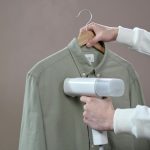When you’re tackling wrinkles, steamers offer quick results without needing an ironing board. They heat up fast and safely refresh delicate fabrics. However, for heavy materials, an iron provides a crisper finish. Steamers are easy to use and portable, making them perfect for busy mornings or travel. On the other hand, irons require a bit more technique and setup. Want to know more about which option suits your needs best? Keep exploring!
Table of Contents
Key Takeaways
- Steamers heat up quickly and can refresh garments directly on hangers, making them ideal for busy mornings.
- Irons provide a crisp finish on heavy fabrics like denim and wool, offering precision for stubborn creases.
- Steamers are easier to use, requiring less technique and providing a beginner-friendly option for wrinkle removal.
- Steamers are more energy-efficient and economical, saving on electricity bills compared to traditional irons.
- Choosing between a steamer and an iron depends on fabric type; delicate materials benefit from steam, while heavy fabrics require pressing.
Speed and Efficiency of Steamers vs. Irons
When it comes to speed and efficiency, steamers often outpace traditional irons. You’ll find that steamers heat up quickly and can tackle wrinkles in just a few swipes.
With a steamer, you can refresh your clothes directly on the hanger, saving you the hassle of setting up an ironing board. This means you can get ready faster, especially on busy mornings.
Plus, steamers are less likely to scorch your fabrics, allowing for more versatility in your clothing choices. If you’re in a rush, the ability to steam multiple garments in a short time can be a game changer.
Fabric Suitability: When to Use Each
When it comes to choosing between a steamer and an iron, fabric type plays a vital role.
Heavy fabrics, like denim and wool, often respond better to an iron for a crisp finish, while delicate materials, such as silk and lace, are safer with a steamer to avoid damage.
Knowing the right tool for your fabric can make all the difference in achieving a polished look.
Heavy Fabrics Preference
While both steamers and irons can tackle wrinkles, heavy fabrics often require a more tailored approach. When you’re dealing with materials like wool, denim, or canvas, a traditional iron is your best bet. Its direct heat and pressing mechanism effectively smooth out stubborn creases. You can use the steam function if your iron has one, as it helps relax the fibers.
On the other hand, steamers can work on heavy fabrics, but they may not provide the same level of precision. If you opt for a steamer, focus on hanging the fabric to allow the steam to penetrate and lift the wrinkles.
Ultimately, knowing your fabric’s needs will help you choose the right tool for a polished look.
Delicate Fabrics Consideration
Heavy fabrics call for specific tools to achieve a crisp finish, but delicate fabrics require a gentler touch. When dealing with silk, lace, or chiffon, you’ll want to choose wisely between a steamer and an iron. Steamers are excellent for these materials as they lightly relax wrinkles without direct contact, preventing damage. On the other hand, irons can scorch or leave marks on delicate fabrics if not used carefully.
| Tool | Best For |
|---|---|
| Steamer | Silk, Chiffon |
| Iron | Cotton, Linen |
| Caution | Avoid scorching |
Always test on a hidden area first to ascertain you’re not ruining your favorite piece. Choosing the right tool can make all the difference!
Setup and Portability: Convenience Factors
Although both steamers and irons effectively remove wrinkles, their setup and portability can greatly influence your choice.
If you’re short on time or space, a steamer might be your best bet. Most models heat up quickly and require minimal setup—just fill the water tank, plug it in, and you’re ready to go. They’re also lightweight and easy to store, making them perfect for travel.
On the other hand, an iron often demands more preparation. You need to set up an ironing board and wait for it to heat up, which can take longer. While irons can be compact, they’re generally bulkier than steamers, making them less convenient for on-the-go touch-ups or small living spaces.
Ease of Use: Learning Curve and User Experience
When it comes to removing wrinkles, ease of use can make a big difference in your experience.
If you’re a beginner, you’ll likely find that a steamer requires less technique and skill compared to a traditional iron. This can take the stress out of the process, allowing you to focus on getting your clothes looking their best.
Beginner-Friendly Operation
Using a steamer or an iron to remove wrinkles can be surprisingly simple, especially for beginners.
If you choose a steamer, you’ll just need to fill it with water, plug it in, and wait a few minutes for it to heat up. Then, you can glide it over your clothes, allowing the steam to relax the fibers. It’s that straightforward!
On the other hand, if you decide to use an iron, you’ll need to adjust the temperature according to the fabric type. Once it’s heated, you can press it down on the garment, moving it carefully to smooth out wrinkles.
Both tools are user-friendly, making them great options for anyone looking to achieve wrinkle-free clothing without a steep learning curve.
Technique and Skill Required
Both steamers and irons have their own techniques that can affect your experience.
With a steamer, you’ll need to hold the nozzle at the right distance from the fabric and use smooth, downward strokes for the best results. It’s relatively easy to master, but you might struggle with stubborn creases at first.
On the other hand, using an iron requires a bit more skill. You’ll have to adjust the heat settings according to fabric type and apply consistent pressure while gliding the iron. This can take some practice to avoid burns or shiny spots.
Ultimately, whether you choose a steamer or an iron, the key lies in your willingness to learn and adapt your technique for ideal wrinkle removal.
Energy Consumption and Cost Considerations
While you might prioritize performance when choosing between a steamer and an iron, energy consumption and cost also play a significant role in your decision.
Steamers generally use less energy because they heat up quickly and require less time to operate. If you’re looking for an economical option, a steamer may save you money on your electricity bill over time.
On the other hand, irons can consume more energy, especially if you need to press multiple garments. Additionally, consider the initial cost; steamers can be more affordable than high-end irons.
Weighing these factors will help you make a more informed choice that fits your budget and energy-saving goals. Don’t overlook the long-term implications of your investment!
Professional and Aesthetic Results: Final Touches
After considering energy and cost factors, it’s time to focus on the results you want to achieve.
If you’re aiming for that crisp, tailored look, an iron is your best bet. It creates sharp creases and delivers a polished finish, perfect for professional settings.
On the other hand, if you prefer a more relaxed, casual vibe, a steamer works wonders. It’s gentle on fabrics and can revive garments without the risk of scorching.
For final touches, always hang your clothes after steaming or ironing to maintain that fresh appearance.
Whichever method you choose, remember that proper technique and care can elevate your look, ensuring you step out with confidence and style.
Your wardrobe deserves that extra effort!
Frequently Asked Questions
Can Steamers Remove Wrinkles From Upholstery and Curtains Effectively?
Yes, steamers can effectively remove wrinkles from upholstery and curtains. You’ll find that the steam penetrates the fabric, relaxing fibers and smoothing out creases. It’s a quick and efficient method for revitalizing your home textiles.
How Do Steamers and Irons Differ in Maintenance Requirements?
Steamers typically require less maintenance than irons. You just need to refill the water tank and occasionally clean the nozzle. Irons, however, need regular descaling and cleaning to prevent mineral buildup and maintain performance.
Are Steamers Safe for All Types of Fabrics?
Yes, most steamers are safe for a variety of fabrics, but you should always check the care label first. Delicate materials like silk may require caution, so test a small area if you’re unsure.
What Are the Best Practices for Storing Steamers and Irons?
To store steamers and irons properly, unplug them, allow them to cool completely, and empty any water. Keep them in a dry, safe place, ensuring cords aren’t tangled or pinched to maintain their longevity.
How Do Travel Steamers Compare to Regular Steamers in Performance?
Travel steamers typically heat up faster and are more portable, but regular steamers generally offer better steam output and larger water tanks. You’ll find travel steamers convenient, but they may not perform as powerfully.
- How to Clean Suede Fabric Shoes: A Definitive Guide - July 12, 2025
- Everything You Need to Know About Faux Suede Fabric - July 12, 2025
- How to Get Wrinkles Out of Suede Fabric - July 12, 2025







